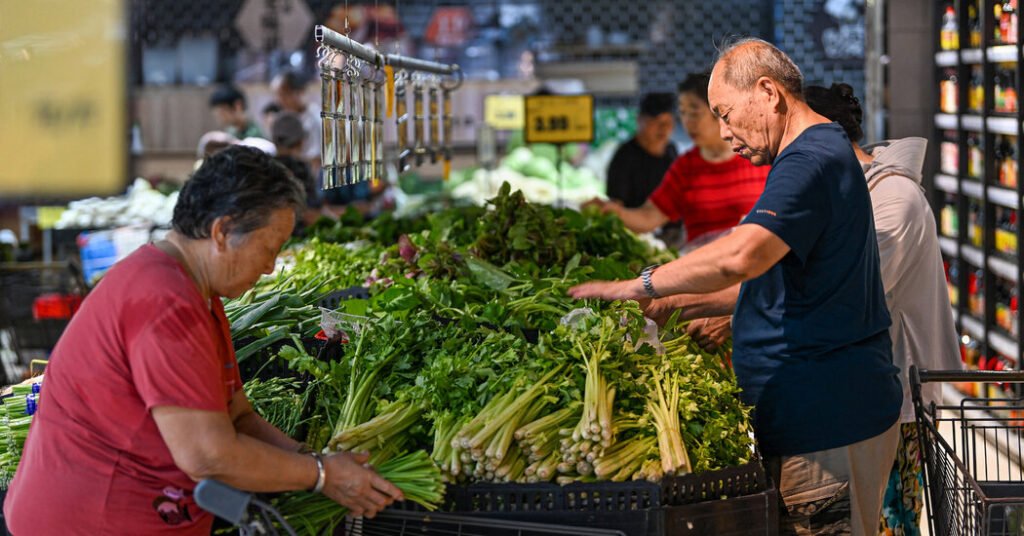After weeks of drought, farmers in the typically arid agricultural belt in northern China were ill prepared for the torrential rain that inundated fields earlier this summer and decimated their crops of eggplant, cucumbers and cabbage.
Farmers in the city of Shijiazhuang, 180 miles from Beijing, showed in a video posted to social media in late August how days of downpours and an overflowing reservoir had turned soil into sludge unfit for growing plants. Across the country, a shift in weather patterns has caught people off guard, with floods arriving two months earlier than usual in the south and then extending to northern and eastern provinces that are more accustomed to summer drought.
The prices of many vegetables nationwide rocketed, some by up to 40 percent, reaching their highest level in five years and hitting the pocketbooks of consumers who already face hard spending choices as China’s economy has slowed.
The extreme weather is a challenge not only for China’s people: The country’s leaders attach great importance to ensuring they can feed its 1.4 billion-person population, seen as necessary for ensuring social stability. They also want people to spend more on consumer goods to boost the sluggish broader economy, rather than paying higher prices for staples such as food.
China’s leader, Xi Jinping, held an emergency meeting of his cabinet in late July to discuss the flooding and its toll on the people. He had a clear message, state media reported: Keep agricultural losses to a minimum and ensure food security. Other senior leaders, including the premier Li Qiang, who is more often photographed in factories and halls of power, made rare visits to shelters and inspected flood-control projects, calling on local officials to step up.
While climate change is upending food supply chains everywhere, it is a particularly sensitive issue in China, where famines have historically led to unrest, and leaders have long made food security a policy priority. The latest flooding is a reminder of how even the ruling Communist Party struggles to tame the unpredictable weather gods.
The stakes are high: China is already the world’s largest food importer and needs to feed almost one-sixth of the world’s population with less than one-tenth of the world’s arable land, which has shrunk and degraded with heavy fertilizer use and pollution. The ranks of farmers have thinned out, with generations of people moving into towns and cities in pursuit of better wages.
Add extreme weather to the list of challenges. More rivers flooded this year than any other since records in China began in 1998, the Ministry of Water Resources said in August. The country this year also recorded its hottest July since at least 1961.
Weather phenomena are expected to become more frequent. While China has made huge investments in updating dams and putting in place warning systems for impending weather events, that money has mostly gone into areas where such events are predictable. Officials now need to be more nimble to keep pace with weather changes in other areas.
“Climate change is another motivating factor for China to focus on food security,” said Darin Friedrichs, the agriculture market research director at Sitonia Consulting. “A common idea in state media and official speeches is the idea that, given its size, China cannot rely on other countries to feed it through imports.”
China suffered more than $10 billion in losses from natural disasters in July, some 90 percent of which was caused by heavy rain and floods, the Ministry of Emergency Management reported, while nearly six million acres of crops were damaged.
Consumers in China’s north and east last month complained in videos posted online by influencers about the price of eggplant, string beans and cucumbers. “It’s so expensive — who can even afford to eat them?” asked one buyer in Yan’an, Shaanxi Province.
The country has been struggling with slower economic growth since the pandemic and has at times seen a broad decline in prices, known as deflation. But when food prices rise, consumers have less money to spend on other items.
“If food prices keep going up for an extended period of time, then it hurts household spending power” in an already sluggish economy, Zongyuan Zoe Liu, the Maurice R. Greenberg senior fellow for China studies at the Council on Foreign Relations, said in a phone interview.
Prices of some vegetables are historically volatile and have already fallen from record highs. Dr. Liu said she expects them to come down more after the rainy season.
But in the longer term, experts say, China’s leaders face more significant challenges. Not long after Mr. Xi came into power in 2012, he warned that the country should not grow complacent over its stable level of grain reserves, saying food security was “a red line that would trigger terrible consequences were it ever to be compromised.”
Ensuring food supplies has become part of Mr. Xi’s political brand. He has declared in numerous speeches the importance of revitalizing rural areas to build a stable base for agriculture. In earlier years, he pushed for a “clean plate campaign” to eliminate “shocking and distressing” squandering of food.
The distribution of water is historically uneven in the country, leaving the south prone to floods and the north vulnerable to drought in the heat of summer. The government invested heavily in nearly 8,000 water conservancy projects across the country, including diverting excess water from large rivers in the south to the northern part of the country.
“The government is — reasonably — directing its investments in flood control infrastructure toward areas where floods have occurred historically,” said Even Pay, an agriculture analyst at Trivium China, a policy research consultancy. “But the problem is that as a result of climate change, those patterns are changing. That means the best infrastructure may be slightly in the wrong place, and some places that are experiencing serious floods now or likely to in the future are underinvested.”
Flood control in cities has sometimes come at the expense of rural residents. Last summer, nearly a million residents of the northern province of Hebei and villages neighboring Beijing had to evacuate after their towns were flooded when officials opened the floodgates to low-lying land surrounding the capital.
For local officials, however, it is often impossible to protect both the larger urban population and those living outside. Officials will face more strategic choices about where floodwater is discharged as floods become more frequent in coming years, experts said.
In July, China’s financial ministry allocated $76.5 million to support disaster relief, with the bulk going into flood relief in provinces along the grain belt and in the south.
Teams of experts were dispatched to drain fields and teach farmers how to clean leaves of sludge. Farmers whose harvests have been ruined were given emergency relief seeds of hardier crops. But that might not be enough, according to Ms. Pay, the policy analyst.
“Depending on where you are geographically by late August, in many regions of the country, there isn’t going to be enough time to grow a new crop before fall harvest,” she said. “And, in those cases, officials are looking at bailouts for the farmers that have been hit the hardest.”


